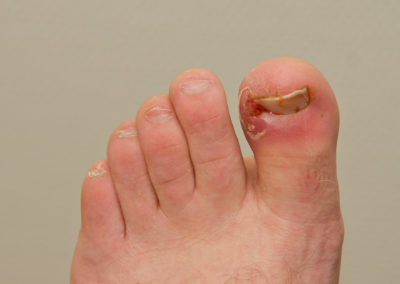Ingrowing Toenail
What is an Ingrowing Toenail?
Ingrowing or thickened toenails are a common problem typically caused by the nail edge cutting or burying itself into the soft flesh around the nail and the condition can be extremely painful. They are often infected and can easily develop into a chronic condition.
They cause pain, difficulty walking, wearing shoes and there is a risk of infection. Ingrown nails usually occur in young people where the nail cuts into the side of the toe. Thick and painful nails occur in older people usually as a result of damage to the nail. Thankfully they are easily treated.
What Causes Ingrowing Toenails?
A number of things can cause an ingrown toenail to develop, including:
- poorly cut toenails: cutting the edges of your toenail or cutting them too short can encourage the skin to fold over your nail and the nail to grow into the skin.
- wearing tight-fitting shoes, socks or tights: restrictive clothing can place pressure on the skin around your toenail and the skin may pierce if it’s pressed on to your toenail.
- sweaty feet: soft skin around the toenail can make it easier for your nail to pierce and embed itself within it.
- injury: something simple like stubbing your toe can sometimes cause an ingrown toenail to develop.
- natural shape of the nail: the sides of curved toenails are more likely to press into the skin surrounding the nail.
What are the Treatment Options for Ingrowing Toenails?
There are a number of treatment options available to help reduce pain and inflammation from ingrowing toenails.
Non-Surgical Treatment Options
Conservative care can help prevent pain or further infection but often won’t cure the problem. In order to successfully treat the condition, you may require an operation, which Mr. Kannegieter may recommend if you have a significant problem or frequent episodes of toenail infection.
Surgical Treatment Options
The operation involves removing the wedge (sliver) of nail that is pressing into the flesh causing your pain.
Once the nail portion is removed, the wound is cauterised with a chemical called Phenol, this prevents this part of the nail bed from regrowing nail. The rest of the nail is usually unaffected, although it may be stained by the Phenol as it heals.
What does the Operation Involve?
The operation only takes about 10 minutes. You will have a bulky dressing on your toe(s) and you should be able to wear your flipflops or slippers for the first day or two.
Are There Risks or Side-Effects Following Ingrowing Toenail Surgery?
As with any medical procedure there are risks which Mr. Kannegieter will always thoroughly explain to you prior to your treatment, so you can be informed every step of the way.
The main risks following surgery are:
- Pain
- Infection
- Deep vein thrombosis
Specific complications of phenolisation:
- The remaining nail will be narrower and can be thickened.
- In some cases, a small shard of nail can re-grow along the edge of the toenail. This is rarely a problem.
- Occasionally the entire nail will shed and a new one will grow in its place.
- The nail may re-grow and cause a further ingrowing toenail. This is uncommon.
What Happens After Surgery?
You should not drive after foot surgery and should be accompanied home by a responsible adult. You will be advised of your follow up appointment date, either on the day or by letter in the post.
Mr. Kannegieter has years of experience treating ingrowing toenails and can discuss the best treatment plan for you.

Resources
Mr. Kannegieter has put together this useful PDF explaining what to expect from ingrown toenail surgery.
